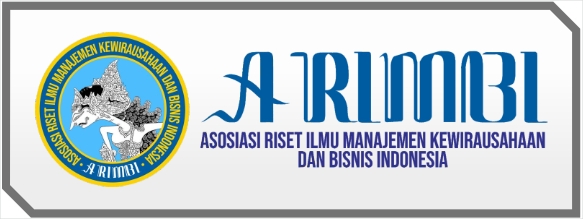MODERASI CITRA LEMBAGA DALAM PENGARUH KUALITAS PELAYANAN AKADEMIK TERHADAP KEPUASAN DAN LOYALITAS
Abstract
Penelitian bertujuan untuk menganalisis pengaruh kualitas layanan pendidikan terhadap kepuasan dan loyalitas, serta pemoderasian citra lembaga dalam pengaruh kualitas pelayanan pendidikan terhadap kepuasan dan loyalitas. Obyek penelitian ini adalah taruna yang ada di Akademi Pelayaran Nasional Surakarta. Sampel yang digunakan dalam penelitian ini sebanyak 248 responden. Teknik pengumpulan data yang digunakan dalam penelitian ini adalah dengan kuesioner. Teknik analisis data yang digunakan dalam penelitian ini adalah dengan uji regresi linier berganda dan moderating regression analysis (MRA). Temuan penelitian ini adalah kualitas pelayanan pendidikan dan citra lembaga mempunyai pengaruh positif dan signifikan terhadap kepuasan dan loyalitas. Sedangkan citra lembaga memoderasi (menguatkan) pengaruh kualitas pelayanan pendidikan terhadap kepuasan dan loyalitas.
References
DAFTAR PUSTAKA
Abdullah, F. (2004). Managing service quality in higher education sector: A new perspective through development of a comprehensive measuring scale. Proceedings of the Global Conference on Excellence in Education and Training: Educational Excellence through Creativity, Innovation & Enterprise, Singapore.
Ali, F., Zhou, Y., Hussain, K., Nair, P., & Ragavan, N. (2014). Does higher education service quality effect student satisfaction, image and loyalty? Quality Assurance in Education, 24(1), 70–94. https://doi.org/10.1108/QAE-02-2014-0008
Alwi, S., & Kitchen, P. (2010). Projecting corporate brand image and behavioral response in business schools: Cognitive or affective brand attributes. Journal of Business Research, 67(11), 2324–2336. https://doi.org/10.1016/j.jbusres.2014.06.020
Appio, J., Tontini, G., & Silveira, A. (2013). Antecedentes da Lealdade e suas Relacoes em Instituicao de Ensino Superior. In Anais do IV Encontro de Ensino e Pesquisa em Administracao e Contabilidade. EnEPQ.
Arrivabene, L. S., Roberto, P., & De, C. L. (2019). Impact of Service Quality , Satisfaction and Corporate Image on Loyalty : A Study of a Publicly Traded for-Profit University. Services Marketing Quarterly, 0(0), 1–17. https://doi.org/10.1080/15332969.2019.1630174
Bitner, M. (1990). Evaluating service encounters: The effects of physical surroundings and employee responses. Journal of Marketing, 54(2), 69–82. https://doi.org/10.1177/002224299005400206
Bolton, R., & Drew, J. (1991). A longitudinal analysis of the impact of service changes on customer attitudes. Journal of Marketing, 55(1), 1–9. https://doi.org/10.2307/1252199
Chandra, T., Ng, M., Chandra, S., & P. (2018). The effect of service quality on student satisfaction and student loyalty: An empirical study. Journal of Social Studies Education Research.
Dehghan, A., Dugger, J., Dobrzykowski, D., & Balazs, A. (2014). The antecedents of student loyalty in online programs. International Journal of Educational Management, 28(1), 15–35. https://doi.org/10.1108/IJEM-01-2013-0007
Donaldson, B., & Mcnicholas, C. (2004). (2004). Understanding the postgraduate education market for UK-based students: A review and empirical study. International Journal of Nonprofit and Voluntary Sector Marketing, 9(4), 346–360. https://doi.org/10.1002/nvsm.259
Douglas, J., Douglas, A., & Barnes, B. (2006). Measuring student satisfaction at a UK university. Quality Assurance in Education, 14(3), 251–267.
Elliott, K. M., & Healy, M. A. (2001). Key factors influencing student satisfaction related to recruitment and retention. Journal of Marketing for Higher Education, 10(4), 1–11. https://doi.org/10.1300/J050v10n04_01
Fernandes, T., & Pedroso, R. (2016a). The effect of self-checkout quality on customer satisfaction and repatronage in a retail context. Springer-Verlag Berlin Heidelberg.
Fernandes, T., & Pedroso, R. (2016b). The effect of self-checkout quality on customer satisfaction and repatronage in a retail context. pringer-Verlag Berlin Heidelberg.
Gioia, D., Hamilton, A., & Patvardhan, S. (2014). mage is everything: Reflections on the dominance of image in modern organizational life. Research in Organizational Behavior, 34(1), 129–154. https://doi.org/10.1016/j.riob.2014.01.001
Golgeli, K. (2014). Corporate reputation management: The sample of Erciyes University. Procedia Social and Behavioral Sciences, 122(15), 312–314. https://doi.org/10.1016/j.sbspro.2014.01.1346
Gruber, T., Fuß, S., Voss, R., & Gl€aser-Zikuda, M. (2010). Examining student satisfaction with higher education services using a new measurement tool. International Journal of Public Sector Management, 23(2), 105–123. https://doi.org/10.1108/09513551011022474
Hanaysha, J., Abdullah, H., & Warokka, A. (2011). Service quality and students’ satisfaction at higher learning institutions: The competing dimensions of Malaysian universities’ competitiveness. The Journal of Southeast Asian Research, 2(1), 2–10. https://doi.org/10.5171/2011.855931
Helgesen, Ø., & Nesset, E. (2007). What Accounts for Students ’ Loyalty ? Some Field Study Evidence. International Journal of Educational Management, 21(2), 126–143. https://doi.org/10.1108/09513540710729926
Hill, Y., Lomas, L., & Macgregor, J. (2003). Students perceptions of quality in higher education. Quality Assurance in Education, 11(1), 15–20. https://doi.org/10.1108/09684880310462047
Joseph, M., & Joseph, B. (1997). Service quality in education: A student perspective. Quality Assurance in Education, 5(1), 15–21. https://doi.org/10.1108/09684889710156549
Kaur, H., & Soch, H. (2013). Mediating roles of commitment and corporate image in the formation of customer loyalty. Journal of Indian Business Research, 5(1), 31–51. https://doi.org/10. 1108/17554191311303376
Ladhari, R., Souiden, N., & Ladhari, I. (2011). Determinants of loyalty and recommendation: The role of perceived service quality, emotional satisfaction and image. Journal of Financial Services Marketing, 16(2), 111–124. https://doi.org/10.1057/fsm.2011.10
Lee, H., Fairhurst, A., & Lee, M. (2009). The importance of self-service kiosks in developing consumers’ retail patronage intentions. Managing Service Quality: An International Journal, 19(6), 687–701.
Lorena Silva Arrivabene, P. R. da C. V. & C. L. de, & Mattoso, Q. (2020). Satisfaction and Loyalty Model for University Students Based on Industrial Revolution 4 . 0 Management. May.
Loureiro, S., & Kastenholz, E. (2011). Corporate reputation, satisfaction, delight, and loyalty towards rural lodging units in Portugal. International Journal of Hospitality Management, 30(3), 575–583. https://doi.org/10.1016/j.ijhm.2010.10.007
Marzo-Navarro, M., Pedraja-Iglesias, M., & Rivera-Torres, P. (2005). Measuring customer satisfaction in summer courses. Quality Assurance in Education, 13(1), 53–65.
Mavondo, F., & Zaman, M. (2000). Student satisfaction with tertiary institution and recommending it to prospective students. In Australian and New Zealand Marketing Academy Conference, Australia. Proceedings, Australia.
Newell, G. (2013). Assessing property student satisfaction with their property education experience in an Australian university. Pacific Rim Property Research Journal, 19(2), 133–150. https://doi.org/10.1080/14445921.2013.11104377
Nguyen, N., & Leblanc, G. (2001). No TitImage and reputation of higher education institutions in students’ retention decisionsle. International Journal of Educational Management, 15(6), 303–311. https://doi.org/10.1108/EUM0000000005909
O’neill, M., & Palmer, A. (2004). Importance-performance analysis: A useful tool for directing continuous quality improvement in higher education. Journal of Quality Assurance in Education, 12(1), 39–52. https://doi.org/10.1108/09684880410517423
Owlia, M., & Aspinwall, E. (1996). A framework for the dimensions of quality in higher education. Quality Assurance in Education, 14(2), 12–20.
Parasuraman, A., & Grewal, D. (2000). The impact of technology on the quality-valueloyalty chain: A research agenda. Journal of the Academy of Marketing Science, 28(1), 168–174. https://doi.org/10.1177/0092070300281015
Parasuraman, A., Zeithaml, V., & Berry, L. (1994). Reassessment of expectations as a comparison standard in measuring service quality: Implications for further research. Journal of Marketing, 58(1), 111–124. https://doi.org/10.2307/1252255
Petruzzellis, L., D’Uggento, A. M., & Romanazzi, S. (2006). Student satisfaction and quality of service in Italian universities. Managing Service Quality: An International Journal, 16(4), 349–364. https://doi.org/10.1108/09604520610675694
Polo, A., Frias, D., & Rodriguez, M. (2013). Antecedents of loyalty toward rural hospitality enterprises: The moderating effect of the customer’s previous experience. International Journal of Hospitality Management, 34(1), 127–137. 10.1108/09684880410517423
Sharabi, M. (2013). Managing and improving service quality in higher education. International Journal of Quality and Service Sciences, 5(3), 309–320.
Smyth, S., Houghton, C., Cooney, A., & Casey, D. (2012). Students experiences of blended learning across a range of postgraduate programmes. Nurse Education Today, 32(4), 464–468. https://doi.org/10.1016/j.nedt.2011.05.014
Soutar, G., & Mcneil, M. (1996). Measuring service quality in a tertiary institution. Journal of Educational Administration, 34(1), 72–82. https://doi.org/10.1108/09578239610107174
Thomas, S. (2011). What drives student loyalty in universities: An empirical model from India. International Business Research, 4(2), 183–192.
Walter, S., Tontini, G., & Carvalho de Souza Domingues, M. (2006). An_alise da satisfacao do aluno para melhoria de um curso de administracao. Revista de Administrac ¸~ao FACES Journal, 5(2), 52–70. https://doi.org/10.1108/IJQSS- 03-2013-0016
Zeithaml, V., & Bitner, M. (2005). Marketing de Servic ¸os: A empresa com foco no cliente (2(1)). Bookman.
DOI: https://doi.org/10.62826/muara.v4i1.40
Refbacks
- There are currently no refbacks.









